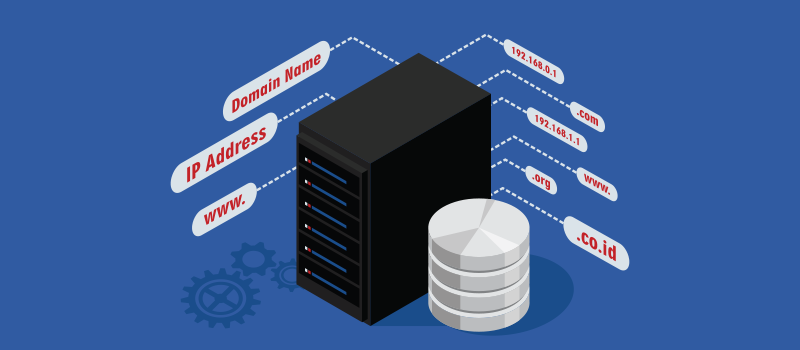Have you ever wondered what happens when you click on a link or type an address in your browser? The page that loads doesn’t appear by magic. The web page you are looking for is just one of 4.6 billion stored on one of 75 million servers around the world and, somehow, it needs to be found and sent back to your screen in a fraction of a second. The reason this is possible is because of Domain Name System.
What is DNS?
DNS or Domain Name System is a system that links domain names to physical IP addresses. For example, when you type https://webhosting.uk.com in your browser, the DNS servers send your request to the IP address where the website is hosted.
To understand this fully, you first need to understand the difference between a domain name and an IP address. A domain name, https://webhosting.uk.com, is the internet address of the website you want to retrieve. However, before you can retrieve the page, you first need to locate the server where it is hosted and give it the instructions to send the right information. This is done through an IP or internet protocol address, a string of numbers and full stops that looks like this: 87.117.236.3.
DNS enables this to happen by storing records about every single website on what is the world’s largest database.
There are two advantages to having both domain names and IP addresses. Firstly, domain names are people friendly and very useful for search engines whereas numerical IP addresses are perfect for sending instructions to computers. Secondly, as IP addresses are linked to a physical server, having a separate type of address allows website owners to swap web hosts without the need to change their domain name: instead, they only need to change the domain’s DNS entry so it points to the nameserver of their new host.
What are DNS records?
DNS records, also called zone files, are instructions for pointing domain names to IP addresses. All domains need a DNS record on the nameserver which controls its IP address.
DNS records also enable the server to handle different requests from a user. The main types of requests received are web page requests (HTTP), File Transfer Protocol requests (FTP) and mail requests (MX).
How DNS Records Work
- The role of the nameserver
Every host has at least two nameservers, specialised servers which remain constantly online and deal with DNS requests from internet users. The process works like this:
- You type a web address e.g. example.com into a browser.
- Your device uses DNS to find example.com’s nameservers.
- It then asks the nameservers for example.com’s IP address.
- The nameserver sends the IP address back to your device.
- The device then sends a request to the IP address asking for the page you are looking for.
- The server on which the website is hosted then sends the page to your browser.
- The main types of DNS record
- A and AAAA records
A and AAAA records are the main DNS records that associate a domain name with a specific IP address. The difference between them is that they use different internet protocol versions: A uses IPv4 and AAAA uses IPv6. - CNAME Records
CNAME Records are used to show that a domain name is an alias for another domain name. This can be useful if you have changed domains and want to send users who visit your old website to your new one. It can also be used if you own range of top level domains (.com, .co.uk, .net, etc.) and want all the users to visit the same website
For example:
Name ? CNAME
example.co.uk ? example.com
Creating the CNAME record above in example.co.uk’s DNS records will send users to example.com instead. - MX Records
MX records are mail exchange records. These are used to specify which mail server is handling the email for your domain. Usually this is done through your host’s mail servers, however, if you choose to use a third-party service, such as Outlook.com, you can create an MX record to ensure that mail sent and received by your domain is handled by the third-party mail servers instead. - TXT Record
TXT records are DNS resource records used to verify the authenticity of an email. Using a TXT record it is possible to verify whether an email purporting to come from a domain actually originated there or whether it had been maliciously sent by a spammer fraudulently using that domain name. This is done by using a DKIM (Domain Key Identified Mail) record which adds an encrypted key in outgoing mail so that receiving mail servers will know whether the mail is genuine or not.
- A and AAAA records
Conclusion
DNS Records are a key component in the infrastructure of the internet. In a way, they are the mappers of the internet, enabling your computer to navigate through the enormous number of domain in order to bring the right page to you screen or the right email to your inbox.
From reading this post you should now have a clearer understanding of
- What DNS is
- The difference between domain names and IP addresses
- What DNS records are
- How DNS Works
- The main types of DNS records and their functions
At Webhosting UK, we have a range of domain services for webmasters, these include domain registration, domain transfer and domain protection (including private nameservers, renewal reminders and theft protection). We can also have tools to help you search for and register unused domains for your business and website. For more information visit our homepage.


